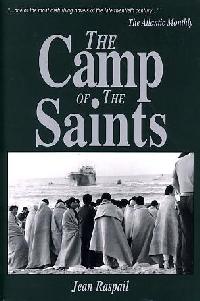The Camp of the Saints
The politics of immigration peril
By William Wetherall
First posted 1 October 2006
Last updated 1 October 2006
Jean Raspail Publishing historyParis: Robert Laffont, 1973, 1985, 2002, 408 pages This futuristic French novel portrays what happens during the three days after a flotilla of natives from the Indian subcontinent wash upon the shores of Southern France. This 1995 edition, put out by a publisher who appears to favor stronger immigration controls in the United States, includes prefatory material on immigration policy movements and controversy over the novel, and on the life and views of its author. Proposition 187A Publisher's Note begins with a reference to California's Proposition 187, a ballot initiative which would have denied illegal immigrants social services, health care, and public education. The note, however, only refers to "the passage" of the proposition, and leaves the impression that is still law. The initiative passed in the 8 November 1994 California gubernatorial election, and it became law the following day. But on 11 November, a federal judge issued a temporary restraining order on grounds that it exceeded state authority in immigration, a federal realm. California dropped its court appeals, effectively killing the law, in 1998. Camp of the Saints mentalityThe prefatory material also include an selective overview of the aftermath of the running aground off Rockaway peninsula beach in New York City of the freighter Gold Venture at 2 in the morning of 6 June 1993. The half page overview ends with the remark that "It is noteworthy that critics who called for stiffer enforcement of U.S. immigration law were accused of displaying a Camp of the Saints mentality. The Camp of the Saints has, in fact, been a very controversial work in the United States. As the Publisher's Note of this edition points out, interest in Raspail's novel was renewed by the December 1994 issue of The Atlantic Monthly, which featured Matthew Connelly's "Must It Be the Rest Against the West?" as one of its cover stories. Jean Raspail on his own novelThe prefatory materials of The Social Contract Press edition also include a 2-page English translation of a French overview of Jean Raspail's life and work, and a 4-page translation of Raspail's introduction to the 1985 French edition. Raspail says this about his novel as literature (pages xiv-xv).
This novel has been both praised as pragmatic and vilified as racist, in the United States, where immigration policy, as in many countries, has a perilistic edge waiting to be sharpened by fear. |
